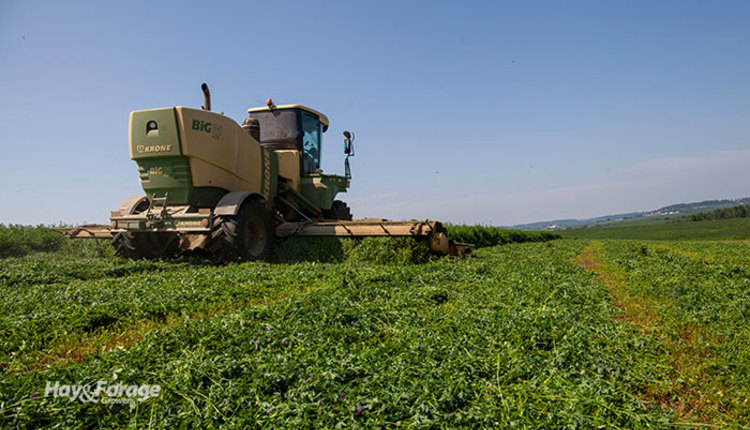
Alfalfa and corn silage work better together, whether it be in cropping rotations or dairy cow rations. Despite the dynamic of the duo, though, alfalfa acreage and inclusion rates have been on the decline for several years in favor of more corn silage being fed to cattle.
Leveraging acreage for homegrown alfalfa may be one limitation for dairy farmers, especially since corn yields more dry matter acre. Other agronomic issues like alfalfa winterkill may also discourage producers from growing more of the perennial forage — but its potential should outpace these problems.
Alfalfa contributes considerable benefits to dairy nutrition and is an excellent complement to corn silage. In fact, in a recent issue of the Midwest Forage Association’s Forage Focus newsletter, Luiz Ferraretto with the University of Wisconsin-Madison says the two crops make a perfect fit for attaining production goals.
“High-quality protein (alfalfa) and rapidly degradable carbohydrates (corn silage) pair nicely, promoting synchronism in the rumen, improving microbial protein production, and boosting milk protein yields,” the ruminant nutrition extension specialist writes.
Ferraretto also points out alfalfa’s fiber characteristics help maintain rumen buffering and health with finer corn silage particles, which allow for greater starch digestibility. With that said, these functions can only be fully realized when alfalfa leaf and dry matter losses are minimized.
The need for leaves
Not only do alfalfa leaves have two to three times more protein than plant stems, but leaf neutral detergent fiber (NDF) is more digestible than stem NDF.
“A 5% increase in leaf loss can decrease protein by 1.2% while increasing NDF by 2.2% in alfalfa. Thus, the proportion of leaves heavily influences nutritive value and forage quality, accounting for up to 70% of the relative forage quality (RFQ),” Ferraretto explains.
Limiting disturbances to alfalfa in windrows during the wilting period will reduce leaf loss. Some loss may be inevitable during baling or chopping, but Ferraretto suggests analyzing practices to pinpoint areas of improvement. Harvesting alfalfa earlier also enhances the power of plant leaves.
“Increasing alfalfa plant maturity makes the stem about 35% less digestible, but leaves often remain relatively unchanged,” Ferraretto states. “Varieties may also change the leaf-to-stem proportion, and consequently, its digestibility,” he adds.
Dry matter matters
In addition to leaf loss, Ferraretto stresses the implications of dry matter loss in the field after harvest. Factors like plant structure, swath structure, and soil and environmental conditions can slow dry down, which exacerbates respiration rates and widens the window of opportunity for rain damage.
When plants respire, they convert carbohydrates stored in their tissues to carbon dioxide, heat, and moisture. This process continues after alfalfa is cut until it is sufficiently dry. Conditioning forage may create a faster escape for moisture in plant stems, and laying forage in a wide swath will promote greater air flow; however, the weather will ultimately dictate dry down.
“In temperate climates, weather is often the most restrictive factor when drying forage,” Ferraretto asserts. “Of all environmental conditions, solar radiation incidence is the most important since the sun’s energy is required to evaporate and move moisture from the plant.”
Rain damage can cause both leaf loss and dry matter loss as raindrops knock leaves off plant stems and leach soluble nutrients from plant tissues. While producers cannot avoid every pitfall, Ferraretto encourages them to preserve forage quality as much as possible to ensure alfalfa’s best attributes are effectively utilized in conjunction with corn silage for dairy rations.

